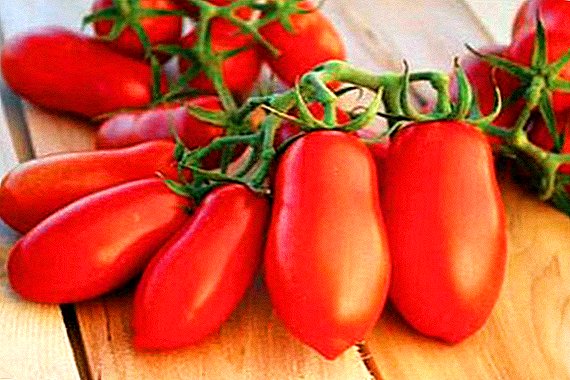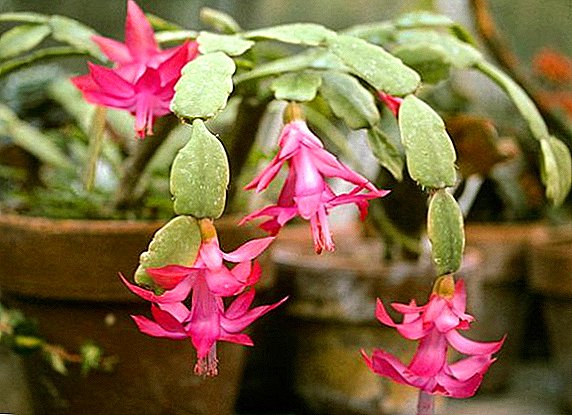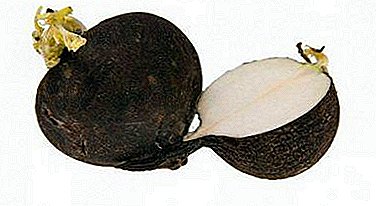
Radish has long been one of the most popular vegetables in Russia. It has long been used in the preparation of many dishes.
Radish will decorate your dishes, make them brighter and tastier. Moreover, it has a large number of useful properties.
This vegetable can be bought in the store, but it will be more useful to grow it in the garden.
Features of growing different types of culture
In agriculture, they grow several types of radish:
- black;
- red;
- green
- white
For the cultivation of radish there are universal rules that are suitable for most varieties. Agrotechnical cultivation has no particular differences.
Compatibility with other cultures
- Radish grows well next to:
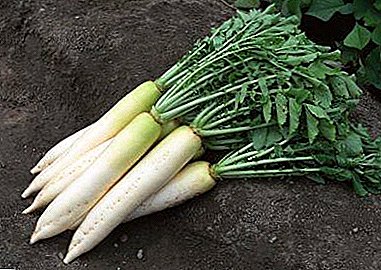 carrots;
carrots;- cucumbers;
- tomatoes;
- melon;
- parsnip;
- beetroot canteen;
- pumpkin;
- spinach;
- fennel;
- legumes;
- cabbage.
- You can not grow a vegetable in close proximity to:
- hyssop;
- bulb onions.
- The best forerunners of radish crops:
- legumes;
- cucumber;
- tomato;
- early potatoes
When to sow?
Planting features depend on radish varieties. In general, the conditions and methods of planting for all varieties of radishes are identical and have no particular differences. Sowing time differs - depending on the variety.
It is customary to divide the radish varieties into:
- summer;
- winter
Sowing material of summer varieties should be planted in the spring, starting from the end of April ending at the end of May. Early varieties of this vegetable are adapted to the effects of low temperatures, which makes it possible to plant them in April. Varieties with average ripening time are sown in May.
Attention! The optimum temperature range for growing radish is eighteen to twenty degrees above zero.
It is desirable that such a temperature was constant after 2 weeks from the moment of germination of seedlings. Based on the climatic conditions of the landing site, it is necessary to adjust the timing of planting seed. For autumn and winter consumption, winter vegetable varieties are planted.
The most suitable time for sowing seeds is from mid-June to mid-July. On average, winter varieties ripen from 100 to 110 days.
When planting radish you need to fatten the climatic features in your area.
Sorta
Radish varieties:
| Green radish | the green goddess, Margilan, southerner; |
| black | night, doctor, murzilka; |
| white | minovasi, Moscow hero, kalancha; |
| red | madam, red winter, red long. |
Where and for how much can you buy seeds?
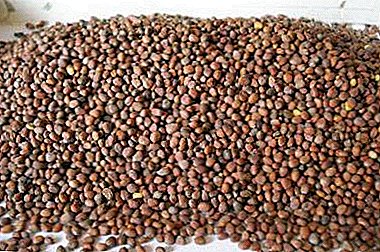 Prices for seed depends on:
Prices for seed depends on:
- manufacturer;
- varieties;
- region of purchase.
On average, in Moscow and St. Petersburg for 1 kg. radish seeds need to pay from 1034 p. (May variety) to 1900 r. (variety "Munich Bir"). It is advisable to purchase seeds from wholesalers and in large volumes, it will save your expenses.
For comparison, the packaging of radish seeds of the Munich Bir variety weighing 2 grams costs 14 rubles. Buying seeds in large quantities you save your money, which will allow you to get a big profit when growing, even in home gardens.
Step by step instructions for sowing
Consider how to plant a vegetable and care for seedlings, ensuring timely watering, thinning and fertilizing.
- Preparation of inoculum. Before carrying out planting it is necessary to carry out preparation of a sowing material. Calibrate the seeds. Small seeds and those with defects should preferably be planted separately - such plants give small fruits, are prone to marksmanship and are subject to the effects of diseases and pests. It is recommended to soak the seeds in a weak solution of manganese or salt during the day.
- Landing. Seeding is carried out according to the scheme:
- In the bed make furrows up to 2 cm in depth at a distance of about 35 cm from one another.
- Lay out in them 3 seeds with an interval of 8 cm between the nests.
- After that, sprinkle the furrows with earth and compact it. If the soil is not wet enough, water the bed after planting.
Shoots may appear in a week.
- Inventory preparation. For planting radish are needed:
- Shovel.
- Rake.
- Hoe.
- Irrigation equipment.
Before landing you need to check its availability and good condition.
 The soil. This plant tolerates the incompatibility of soil conditions with the optimum level. But to get rich yields you need to know that the yield and taste of vegetables depend on the quality of the soil. The optimal soil for these roots is loam, rich in humus and humus, as well as sandy loam.
The soil. This plant tolerates the incompatibility of soil conditions with the optimum level. But to get rich yields you need to know that the yield and taste of vegetables depend on the quality of the soil. The optimal soil for these roots is loam, rich in humus and humus, as well as sandy loam.Radish does not like acidic soils. If the soil is sour, then it should be lime. It is necessary to carry out preplant preparation of the soil in the form of plowing and harrowing (in the conditions of large farms) or digging and tillage with a rake (in the conditions of country farms).
- Watering. Once a week you need to carry out watering crops. Watering should be moderate. Watering can be carried out using buckets or irrigation systems. For 1 square meter you need 10 liters of water.
- Thinning. At emergence of shoots it is necessary to carry out thinning sprouts. It is also very important to weed the beds and clean them of weeds.
- Fertilizers. Top dressing can be carried out only by mineral fertilizers. Use of organic is undesirable, as they have a bad effect on the growth of radish.
It is advisable to use complex mineral supplements that contain nitrogen, potash, phosphate fertilizers and trace elements in the right quantities for good plant growth. It is necessary to conduct 2 dressings: 1 when sprouts appear, the second approximately 20 days after the first.
Using manure as a fertilizer, perhaps no earlier than one year before sowing the radish. These crops do not perceive the impact of manure. It is recommended autumn dressing of the soil with potash and phosphate fertilizers (superphosphate and potassium nitrate).
The video provides step-by-step instructions for sowing radish:
How to plant in open land using two methods?
This vegetable is known for its cold resistance. Shoots begin to germinate at a temperature of three degrees of heat, and can tolerate short-term frosts to minus four degrees. Adult cultures tolerate cooling to minus six degrees.
Radish can be grown by planting:
- seeds;
- seedlings.
When planted in radish seedlings, seeds are sown a month before planting in open ground. This method is used to obtain early yields. After that, the grown seedlings are planted in open ground. The seedless way is recommended when growing a culture under a film cover.
In the greenhouse
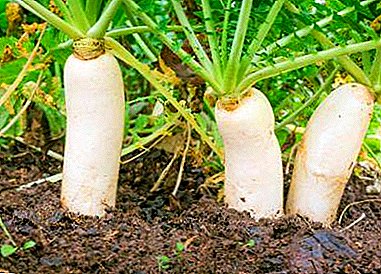 For early harvests of this root can be grown in greenhouses or greenhouses in greenhouses. This will allow to have roots in the autumn-winter period.
For early harvests of this root can be grown in greenhouses or greenhouses in greenhouses. This will allow to have roots in the autumn-winter period.
When the temperature of growing in the greenhouse increases, the radish reacts in the form of abundant growth of the root, therefore when grown in the greenhouse, it is desirable to heat the soil to fifteen degrees of heat.
A short exposure to low temperatures in the greenhouse will cause significant damage to crops, but a constant temperature below ten degrees of heat will increase the growth period of the plants by about two weeks. In hot weather, it is advisable to air the greenhouses.however avoid drafts.
To create favorable conditions in the greenhouse you need to prepare a fertile substrate, fertilizing is also recommended, as well as when grown in open ground.
For greenhouses the most adapted varieties:
- "Day";
- "Runder Weiser";
- "Munich hothouse".
At home
It is possible to grow radish at home. To do this, you need to purchase a sufficiently deep container, preferably deeper than 20 cm. It is also important to maintain the temperature regime for growing crops. Economically it is not advisable to grow radish at home!
When grown at home you need to meet all basic requirements, as well as when growing in greenhouses.
Possible problems and difficulties
Radish is a very unpretentious culture. Properly organized landing can not cause any difficulties. Problems may arise in the absence of watering. Problems may also arise from exposure to pests and diseases.
Currently there is a wide range of fungicides and insecticides that will preserve your crop without loss of commercial quality and taste. Growing radish on the garden will provide your table with tasty and healthy vegetables. Their cultivation is not difficult. And in spring or summer, with proper care for seedlings grown from seed, or for seedlings in open ground or greenhouse, you will get a rich harvest in due time.


 carrots;
carrots; The soil. This plant tolerates the incompatibility of soil conditions with the optimum level. But to get rich yields you need to know that the yield and taste of vegetables depend on the quality of the soil. The optimal soil for these roots is loam, rich in humus and humus, as well as sandy loam.
The soil. This plant tolerates the incompatibility of soil conditions with the optimum level. But to get rich yields you need to know that the yield and taste of vegetables depend on the quality of the soil. The optimal soil for these roots is loam, rich in humus and humus, as well as sandy loam.




